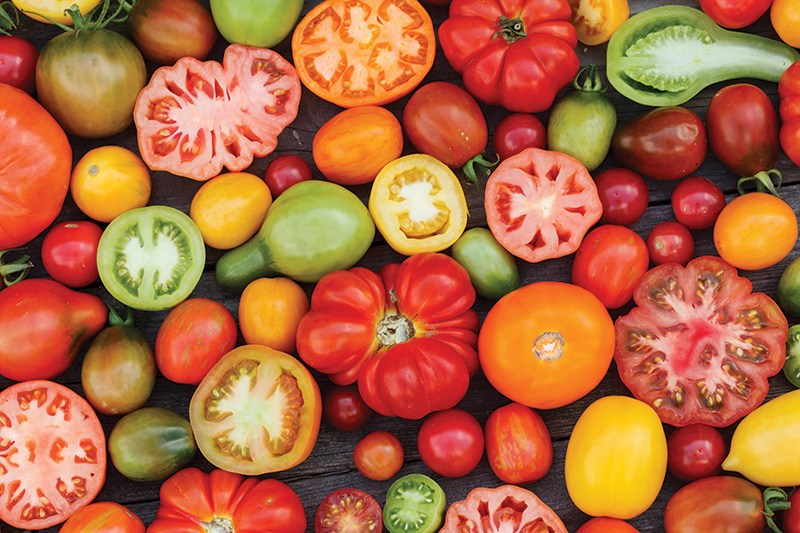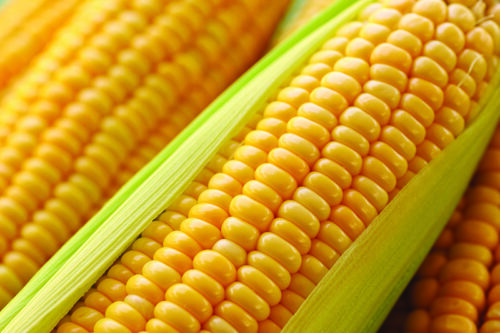Over the years, I have happily amassed knowledge about two culinary stars that always show up around mid-June: tomatoes and corn. Did you know there are at least 10,000 varieties of tomatoes and six different types of corn? Or that the skins from tomatoes and the starch from corn can be used in soups and stews? From summer through early fall, both are nearly as available as water and air, but they are far more flavorful. Roasted, grilled, sauteed, or boiled, these two ingredients will always astonish if you follow these tips.
TOMATOES
BUYING
If available, always buy locally grown tomatoes. Supermarket tomatoes are produced to be durable, not flavorful. Red tomatoes are harvested while still green, gassed to turn red, and transported who-knows-how-many miles. A good tomato will have the strong aroma of both the vine and the tomato. Remember, not all tomatoes are red. Heirloom tomatoes — of which there are some 3,000 in active cultivation — come in a wide variety of colors, shapes, flavors, and sizes.
STORING
Because tomatoes continue to ripen after they are picked, store them, stem side down, at room temperature away from sunlight. While the refrigerator kills a raw tomato’s aroma and texture, you can freeze uncooked tomatoes, whether they’re whole, halved, quartered, or chopped. Their texture will suffer, but their flavor will not.
CUTTING
When slicing a whole tomato, reach for a serrated knife. When chopping a whole tomato, use a very sharp paring knife or chef’s knife. To avoid losing all the juices as you chop, put the cutting board inside a rimmed sheet pan. It will collect the juices that run off the board. To halve a bunch of cherry tomatoes all at once, place them between two upside-down plates on the counter and press down gently on the top plate. Run a serrated knife between the plates, slicing the tomatoes in half with one clean stroke.
PEELING
To easily peel tomatoes, bring a pot of water to a boil, core the tomatoes, and score a tiny cross in the bottom of each. Blanch in the water until the skins begin to curl back at either the core or the scored spot (usually for under one minute). Transfer them to a bowl of ice water and leave them for another minute before peeling. Don’t throw out the peels, as they are a wonderful seasoning for soups and stews. Lay them on a sheet pan lined with parchment paper, bake at 200 F until crispy, and then grind into a powder.
DESEEDING
Many recipes advise you to deseed tomatoes because they are considered bitter. Not only is this a pain, but in removing the seeds, you are also discarding the tomato jelly around them, a flavor firecracker that contains high levels of umami-rich glutamic acid. If you are determined to lose the seeds (which really aren’t so bitter), press the jelly through a sieve to catch them, and then add the jelly back to the chopped tomatoes.
FLAVORING
Tomatoes play nicely with just about any herb: mint, basil, cilantro, chives, oregano, dill, parsley, tarragon, and thyme. However, before eating or using tomatoes in a recipe, amplify their taste by salting them, which also removes excess water. (Ninety-five percent of a tomato’s weight is water.) Then leave them to drain in a colander for 20 minutes. (This is a crucial step when making a tomato tart to avoid ending up with a bland, watery mess.)
CORN
BUYING
Though there are six types of corn, sweet corn is the one we care about. (The other types are used for ethanol; animal feed; and products like corn starch, syrup, tamales, and tortillas.) Sweet corn comes in several colors — white, yellow, and multicolored — though the color does not indicate sugar content. Sweet corn is best if eaten almost immediately after being harvested and before the natural sugar content turns to starch. Many commercial varieties have been developed that mimic and extend the sweetness of freshly picked corn, but the ears taste more like sugar than corn. So, whenever possible, buy locally grown corn, but early in the day before it has spent too much time in the sun. Look for full ears with a green husk (and no dry edges). Don’t peel back the top. Instead, feel the outside of each ear as fully developed corn will be full from end to end.
STORING
Put corn directly into the refrigerator and eat it that day. To freeze corn, cut the raw kernels off the cob, spread them in a layer on a sheet pan, and freeze. Once frozen, transfer them into an airtight container and store them in the freezer.

CUTTING
Corn on the cob is a dependable pleasure. But if a recipe requires just kernels, cut the husked corn in half, crosswise, and place the halved cob (cut-side down) on a cutting board. Set the cutting board inside a rimmed sheet pan to catch any wandering kernels while you are cutting. When done, scrape the cobs with the dull side of the knife to reap the tasty corn milk and then add it to whatever dish you are creating to boost the flavor.
COOKING
There are many ways to cook corn, but my two favorites are grilling and boiling. A foolproof method for preventing overcooked, mushy corn is to bring a large pot of water to a boil, then turn off the heat. Add up to six cobs, cover the pot, and let stand for 10 minutes before eating. To grill corn in the husk, soak the ears in water for an hour before. Grill, turning occasionally until fragrant and steaming, about 10 minutes. Let cool slightly before removing the husk. Personally, I prefer the toasty popcorn taste of it grilled without the husk. Oil the shucked corn, sprinkle lightly with salt, and grill over medium-high heat for around 10 minutes, turning until golden on all sides.
FLAVORING
If you’re cooking corn in water (rather than grilling), don’t add salt — it won’t penetrate the kernels. Wait until it’s finished cooking and, if you’ve slathered the cob with butter, then sprinkle on the salt. Corn is happy to be paired with any of the herbs recommended above for tomatoes. As an aside, corn cobs simmered for 15 to 20 minutes in stock or water add a ton of corny flavor to a soup or stew. Similarly, if you’re making creamed corn or a creamy soup, thicken it and add flavor by puréeing one cup of raw corn in a blender with 1/2 cup of stock or water before adding it to your recipe.

Cookbook author Sara Moulton (saramoulton.com) is currently the host of the public television show “Sara’s Weeknight Meals.”





